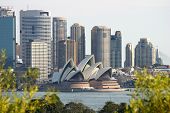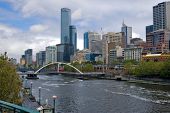Australian Weather
Australia experiences temperate weather for most of the year but the climate can vary due to the size of our continent. The northern states typically experience warm weather much of the time, with the southern states experiencing cooler winters. Australia is also one of the driest continents on earth with an average annual rainfall of less than 600 millimetres. Like all countries in the southern hemisphere, Australia’s seasons are opposite to those in the northern hemisphere. December to February is summer; March to May is autumn; June to August is winter; and September to November is spring.

Weather in Sydney, New South Wales
Victoria’s climate is marked by a range of different climate zones, from the hot, dry regions of the northwest to the alpine snowfields in the northeast. Average annual rainfall ranges from less than 250 millimetres in parts to in excess of 1800 millimetres over some of the mountainous regions. Melbourne has a reputation for its changeable weather, but as a general rule, the city enjoys a temperate climate with warm to hot summers; mild, balmy springs and autumns; and cool winters. Temperatures average 25°C in summer and 14°C in winter. Rainfall is highest from May to October.

Weather in Melbourne, Victoria
New South Wales lies in the temperate zone. The Great Dividing Range, in the east of the state, has a large impact on the climate, creating four distinct zones: the coastal strip, the highlands, the Western Slopes and the flatter country to the west. Sydney’s climate is pleasantly temperate all year round with more than 340 sunny days a year. In summer (December to February), average maximum temperatures in Sydney are around 26°C. It can also be humid at this time with an average humidity of 65 per cent. Average maximum temperatures in the winter (June-August) are around 16°C. Sydney’s rainfall is highest between March and June.

Weather in Perth, Western Australia
Western Australia has a number of climatic zones due to its enormous size. In the north-west, heavy rains mark the summer ‘wet’ season, although the interior is mostly dry with high summer temperatures; while the southwest has mild, wet winters and hot, dry summers. Perth’s rainfall is highest between May and September. February is usually the hottest month of the year, averaging temperatures of 31°C. A sea breeze called ‘The Fremantle Doctor’, blows from the south-west providing relief from the heat. Winters are relatively cool and wet with temperatures of around 18°C.

Weather in Brisbane, Queensland
Brisbane has a subtropical climate with warm or hot weather for most of the year. In summer (December – February), maximum temperatures average around 30°C. The city experiences most rainfall in summer which can sometimes take the form of thunderstorms with torrential rain. It can be very humid during this time. Winter is generally dry, mild and pleasant. Most winter days are sunny with average temperatures of around 17°C. Average monthly rainfall over the year is around 96 millimetres.

Weather in Hobart, Tasmania
Since Tasmania is an island with no place more than 115 kilometres from the sea, its climate is classified as mild temperate maritime. Summers are mild and rainfall is spread fairly evenly throughout the year, although the winter months are the wettest. Because of its latitude, the seasons are much more evident in Tasmania than the rest of Australia. Hobart has four distinct seasons. The warmest months, January and February, are also the driest with average temperatures of around 21°C. While exposed to the southerly winds from the Antarctic, Hobart is protected by Mt Wellington from the worst weather.

Weather in Canberra, Australian Capital Territory
Canberra has a mostly dry, continental climate with warm to hot summers and cool winters. The average annual rainfall is 629 millimetres which is fairly evenly distributed throughout the year. The wettest month is October and the driest is June. During winter, snow falls in the nearby Australian Alps. January is the hottest month with average maximum temperatures of 28°C. The coldest month is July with average daily temperatures of 11°C which can drop below zero at night. Canberra has around nine hours a day of sunshine in summer, dropping to around five hours in winter.